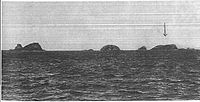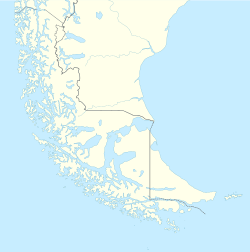Evangelistas Islets facts for kids
|
Native name:
Islotes Evangelistas
|
|
|---|---|

Photo of the islets by George Henry Slight, the arrow indicating the site of the lighthouse
|
|
| Geography | |
| Coordinates | 52°23′10″S 75°05′12″W / 52.386025°S 75.086615°W |
| Adjacent bodies of water | Pacific ocean |
| Total islands | 4 |
| Administration | |
| Region | Magallanes y la Antártica Chilena |
| Province | Última Esperanza |
| Commune | Puerto Natales |
| Additional information | |
| NGA UFI=-882479 | |
The Evangelistas Islets (pronounced: Ee-van-jeh-LEES-tas Eye-lets) are a group of four small, rocky islands. They are located in the Pacific Ocean, off the coast of Chile. These islets are about 30 kilometers (18 miles) northwest of the western entrance to the Strait of Magellan. This area is known for its very strong winds and rough seas, often called the "Furious Fifties".
The Chilean Navy is in charge of these islands. They manage the Chilean Maritime Signalling Service. The Navy has been present on the islets since 1896. This was when the Evangelistas Lighthouse was built by a Scottish engineer named George Henry Slight.
A long time ago, on February 17, 1676, a group of sixteen men faced a difficult situation at the Evangelistas Islets. They were part of an expedition led by Pascual de Iriate. They were trying to place a bronze plaque to show that the King of Spain owned the area. Sadly, these men were lost during this attempt.
Contents
Exploring the Evangelistas Islets
The Evangelistas Islets are mostly bare rock. They have steep cliffs on their western sides. This makes them very exposed to the strong winds and rough ocean waves.
The Main Islet: Evangelistas Grande
The largest island in the group is called Evangelistas Grande.
- It is about 400 meters (1,300 feet) long and wide.
- It reaches a height of 60 meters (200 feet).
- This is where the important Evangelistas Lighthouse stands.
Other Islets and Wildlife
The other three islets are not inhabited by people. They are:
- Elcano: This islet is about 300 by 100 meters (980 by 330 feet).
- Lobos: This islet is about 400 by 150 meters (1,300 by 490 feet).
- Pan de Azúcar: This islet is about 200 by 200 meters (660 by 660 feet).
Lobos and Elcano are special because they are home to many black-browed albatrosses. These large seabirds use the islets as a place to breed and raise their young. In 2002, an aerial survey counted about 4,670 pairs of these albatrosses living there. Because of these important colonies, BirdLife International has recognized the islets as an Important Bird Area (IBA). This means they are a very important place for birds.
Climate and Weather
The Evangelistas Islets experience a cool and very wet climate. The temperatures do not change much throughout the year.
- Temperatures: The average temperature is around 8.3°C (47°F) in the warmest months (January and February). In the coldest months (July and August), the average temperature drops to about 4.4°C (40°F).
- Rainfall: The islets receive a lot of rain throughout the year. The total rainfall is about 2,570 millimeters (101 inches) annually. This is a very high amount of precipitation.
- Humidity: The air is almost always humid, with humidity levels usually around 83%.
This climate is typical for islands in the "Furious Fifties" region, known for its strong winds and frequent storms.
See also
 In Spanish: Islotes Evangelistas para niños
In Spanish: Islotes Evangelistas para niños
- List of islands of Chile



